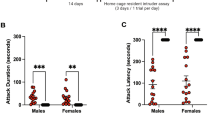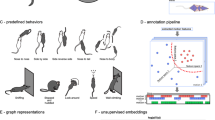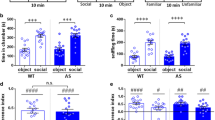Abstract
Territorial reactive aggression in mice is used to study the biology of aggression-related behavior and is also a critical component of procedures used to study mood disorders, such as chronic social defeat stress. However, quantifying mouse aggression in a systematic, representative, and easily adoptable way that allows direct comparison between cohorts within or between studies remains a challenge. Here, we propose a structural equation modeling approach to quantify aggression observed during the resident-intruder procedure. Using data for 658 sexually experienced CD-1 male mice generated by three research groups across three institutions over a 10-year period, we developed a higher-order confirmatory factor model wherein the combined contributions of latency to the first attack, number of attack bouts, and average attack duration on each trial day (easily observable metrics that require no specialized equipment) are used to quantify individual differences in aggression. We call our final model the Mouse Aggression Detector (MAD) model. Correlation analyses between MAD model factors estimated from multiple large datasets demonstrate generalizability of this measurement approach, and we further establish the stability of aggression scores across time within cohorts and demonstrate the utility of MAD for selecting aggressors which will generate a susceptible phenotype in social defeat experiments. Thus, this novel aggression scoring technique offers a systematic, high-throughput approach for aggressor selection in chronic social defeat stress studies and a more consistent and accurate study of mouse aggression itself.
Similar content being viewed by others
Log in or create a free account to read this content
Gain free access to this article, as well as selected content from this journal and more on nature.com
or
References
Miczek KA, Faccidomo S, de Almeida RMM, Bannai M, Fish EW, Debold JF. Escalated Aggressive Behavior: New Pharmacotherapeutic Approaches and Opportunities. In: Devine J, editor Youth Violence: Scientific Approaches to Prevention. New York, NY, US: New York Academy of Sciences; 2004. p. 336–55.
Golden SA, Jin M, Shaham Y. Animal Models of (or for) Aggression Reward, Addiction, and Relapse: Behavior and Circuits. J Neurosci. 2019;39:3996–4008.
Miczek KA, de Boer SF, Haller J. Excessive aggression as model of violence: a critical evaluation of current preclinical methods. Psychopharmacology (Berl). 2013;226:445–58.
Golden SA, Heshmati M, Flanigan M, Christoffel DJ, Guise K, Pfau ML, et al. Basal forebrain projections to the lateral habenula modulate aggression reward. Nature. 2016;534:688–92.
Golden SA, Covington III HE, Berton O, Russo SJ. A standardized protocol for repeated social defeat stress in mice. Nat Protoc. 2011;6:1183–91.
Krishnan V, Han M-H, Graham DL, Berton O, Renthal W, Russo SJ, et al. Molecular Adaptations Underlying Susceptibility and Resistance to Social Defeat in Brain Reward Regions. Cell. 2007;131:391-404.
Kudryavtseva NN, Bakshtanovskaya IV, Koryakina LA. Social model of depression in mice of C57BL/6J strain. Pharmacol Biochem Behav. 1991;38:315–20.
Hamm JA, Hoffman L. Working with Covariance: Using Higher-Order Factors in Structural Equation Modeling with Trust Constructs. In: Shockley E, Neal TMS, PytlikZillig LM, Bornstein BH, editors. Interdisciplinary Perspectives on Trust: Towards Theoretical and Methodological Integration. Cham: Springer International Publishing; 2016. p. 85–97.
Oyegbile TO, Marler CA. Winning fights elevates testosterone levels in California mice and enhances future ability to win fights. Horm Behav. 2005;48:259–67.
Golden SA, Aleyasin H, Heins R, Flanigan M, Heshmati M, Takahashi A, et al. Persistent conditioned place preference to aggression experience in adult male sexually-experienced CD-1 mice. Genes Brain Behav. 2017;16:44–55.
Jöreskog KG. A general approach to confirmatory maximum likelihood factor analysis. Psychometrika. 1969;34:183–202.
Koolhaas JM, Coppens CM, de Boer SF, Buwalda B, Meerlo P, Timmermans PJA. The Resident-intruder Paradigm: A Standardized Test for Aggression, Violence and Social Stress. J Vis Exp. 2013:e4367.
Olivier B, Young LJ. Animal Models of Aggression. In: Davis KL, Charney D, Coyle JT, Nemeroff C, editors. Neuropsychopharmacology: The Fifth Generation of Progress. Philadelphia, PA: Lippincott Williams & Wilkins; 2002. p. 1699–708.
Eagle AL, Manning CE, Williams ES, Bastle RM, Gajewski PA, Garrison A, et al. Circuit-specific hippocampal ΔFosB underlies resilience to stress-induced social avoidance. Nat Commun. 2020;11:4484.
Nilsson SRO, Goodwin NL, Choong JJ, Hwang S, Wright HR, Norville ZC, et al. Simple Behavioral Analysis (SimBA) – an open source toolkit for computer classification of complex social behaviors in experimental animals. bioRxiv. 2020:1–29.
Rosseel Y. lavaan: An R Package for Structural Equation Modeling. J Stat Softw. 2012;48:1–36.
RStudio Team. RStudio: Integrated Development for R. Boston, MA: RStudio, Inc.; 2020.
Bender AR, Raz N. Normal-appearing cerebral white matter in healthy adults: mean change over 2 years and individual differences in change. Neurobiol Aging. 2015;36:1834–48.
Hu Lt, Bentler PM. Cutoff criteria for fit indexes in covariance structure analysis: Conventional criteria versus new alternatives. Struct Equ Modeling A Multidiscip J. 1999;6:1–55.
Satorra A, Bentler PM. Ensuring Positiveness of the Scaled Difference Chi-square Test Statistic. Psychometrika. 2010;75:243–48.
Datta SR, Anderson DJ, Branson K, Perona P, Leifer A. Computational Neuroethology: A Call to Action. Neuron. 2019;104:11–24.
Goodwin NL, Nilsson SRO, Golden SA. Rage Against the Machine: Advancing the study of aggression ethology via machine learning. Psychopharmacology. 2020;237:2569–88.
de Boer SF, van der Vegt BJ, Koolhaas JM. Individual Variation in Aggression of Feral Rodent Strains: A Standard for the Genetics of Aggression and Violence? Behav Genet. 2003;33:485–501.
Newman EL, Covington HE, Suh J, Bicakci MB, Ressler KJ, DeBold JF, et al. Fighting Females: Neural and Behavioral Consequences of Social Defeat Stress in Female Mice. Biol Psychiatry. 2019;86:657–68.
Warren BL, Mazei-Robison MS, Robison AJ, Iñiguez SD. Can I Get a Witness? Using Vicarious Defeat Stress to Study Mood-Related Illnesses in Traditionally Understudied Populations. Biol Psychiatry. 2020;88:381–91.
Author information
Authors and Affiliations
Contributions
CCK, ALE, NG, SAG, and AJR conceived and interpreted experiments; CCK, ALE, IN, and NG performed experiments; KM provided critical support for experiments; CCK, HA, and ARB performed the analysis; CCK and AJR wrote the paper; all authors revised the manuscript.
Corresponding author
Additional information
Publisher’s note Springer Nature remains neutral with regard to jurisdictional claims in published maps and institutional affiliations.
Supplementary information
Rights and permissions
About this article
Cite this article
Kwiatkowski, C.C., Akaeze, H., Ndlebe, I. et al. Quantitative standardization of resident mouse behavior for studies of aggression and social defeat. Neuropsychopharmacol. 46, 1584–1593 (2021). https://doi.org/10.1038/s41386-021-01018-1
Received:
Revised:
Accepted:
Published:
Issue date:
DOI: https://doi.org/10.1038/s41386-021-01018-1
This article is cited by
-
Activation of somatostatin neurons in the medial amygdala reverses long-term aggression and social deficits associated to early-life stress in male mice
Molecular Psychiatry (2025)
-
Simple Behavioral Analysis (SimBA) as a platform for explainable machine learning in behavioral neuroscience
Nature Neuroscience (2024)
-
Induction of territorial dominance and subordination behaviors in laboratory mice
Scientific Reports (2024)
-
Sex differences in appetitive and reactive aggression
Neuropsychopharmacology (2022)
-
Excessive alcohol consumption after exposure to two types of chronic social stress: intermittent episodes vs. continuous exposure in C57BL/6J mice with a history of drinking
Psychopharmacology (2022)



